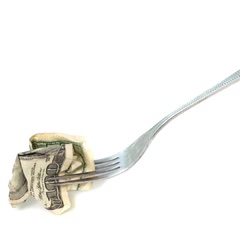
For many of the long-term care communities we work closely with, one of the greatest challenges we understand is managing the financial piece of their foodservice operations. And it’s not difficult to see why.
Just think of the variables food service managers must consider to stay within budget and still mimic a perfect restaurant-dining experience…
- Constantly having quality food on hand and ample options.
- The cost of food and foodservice materials can change with the market almost weekly, making it more challenging to budget appropriately.
- Residents come and go, begging the question, “how many people do I need to cook for today?”
- Employees not following serving size requirements (over-portioning) or the menu.

Talk about a moving target! The first thing we want to do is applaud dining managers for their hard work and insistence on always providing residents with the best foodservice possible. It’s not easy to do what you do, but trust us when we say that your residents are singing your praises!
The best news is that you can still keep everyone happy without losing control of your budget! There are things you can do right now to simplify costs, save money, avoid plate waste, make the most out of your budget, and alleviate any confusion among you and your staff. Let’s discuss a few budget and money management tips for your foodservice department.
How expensive is your trash these days?

Consider this: Each pound of food costs $1.10. So, if 68 pounds of food is wasted per day, that breaks down to:
$74.80 lost per day and $523.60 per week
And get this…more than $27,000 per year!
The answer: Take a close look at the trash you are throwing away each day.
What do you see? Do you see too much uneaten food that was served? Do you see food that had to be tossed because it was expired? While digging through the trash isn’t the first thing most of us want to do each day, doing so provides a clear picture of plate waste, how much your staff is serving to each resident, and whether or not you have firm control over your inventory and food production.
Tip 1 — Rotate products and be mindful of excess or short-dated inventory.
Tip 2 — Always follow the recipe. Never estimate.
Tip 3 — Prepare and hold food for short time periods. This prevents waste and improves quality.
Tip 4 — Follow the serving size and use the correct utensils.
Tip 5 — Consider pre-cut produce and meat to reduce waste.
Maximize every dollar in your operation
Offer vs. Serve — One mistake foodservice operations make is that they serve without asking their residents first. Instead of pre-setting a table, ask the residents as they sit down about their beverages, breads, and desserts. This way, you only serve what is being requested, thus reducing the potential for waste.
Monitor resident numbers — Always keep an eye on how many residents are in the building and ensure your production reflects the current needs of those residents. This will help avoid over-spending.
Secure your vault — Believe it or not, but many foodservice operations have a problem with food theft. Check your inventory frequently and tightly monitor food storage and preparation.
Better Budget Management

Here are a few steps to improve your operational expenses:
- Set a schedule to review contracts, inventory, and budget goals with the finance manager, administrator, etc.
- Spend time in the dish room evaluating waste and determining the root cause.
- Frequently evaluate diet orders and supplements with the Dietitian.
- Carefully evaluate all aspects of the operation including employee actions during food preparation, cooking, and serving.
- Determine scheduled activities for performance improvement.
A successful dining operation doesn’t have to hurt your budget
Achieving the perfect restaurant-style dining experience is a delicate balancing act that requires you to look at everything from what’s on your menu to your staff, budget, service limitations, tools and resources already on-hand, resident needs, etc. If you’re just starting on your journey, our suggestion is to start with small goals and make incremental changes.
This is not something you can achieve overnight — it’s a journey. And we are here to help you get there!
DiningRD is committed to improving dining and nutrition services in healthcare communities through expert clinical consulting, innovative menu solutions, and training support for food service teams. Our state-of-the-art TableSide dining management program includes production reports, tallies, rosters, and other resources to help improve your operational awareness, as well as innovative tools to help modify recipes and add new menu options that meet your budget. Contact us today – RD@DiningRD.com
